FORWARD FACING: Innovations that are Moving Building Enclosure Design, Fabrication, Installation and Performance in Bold New Directions
Window trends aren’t limited to new construction. More and more existing buildings are being renovated in a way that respects their historic character while incorporating the latest fenestration technologies, including new materials, more energy-efficient glass, and new muntin options. Sometimes historic preservation mandates dictate that the existing windows be replaced with windows of the same material as the original windows; in other cases, the original windows are replaced with new materials and muntins. Either way, the goal is the same–preserve the original character of the building as expressed in the fenestration appearance, but update the performance to meet current needs.
The rigors of budget and schedule come to play regardless of building type or age. As a result, there is an increasing desire for fenestration systems that are factory-engineered and pre-glazed to expedite installation during the construction phase. Of course, there is also a desire to be more creative in building designs, resulting in increasingly complex facade systems with many plane changes, large expanses of glass, offsets, corners, tilts, glass types, spandrels, curved glass, etc. The key to a successful fenestration solution is to understand all of the options available and strive for an appropriate balance between design and performance.
Storefront and Curtain Wall Systems
While we have looked at fenestration in general, let’s look a little closer at two common commercial facade systems, namely storefront and curtain wall systems. Storefront systems take their name from retail settings, where they are commonly used for large, single-floor height openings of glass. These systems are intended for light commercial single-story retail viewing and readily incorporate doors and entrances for quick access to interior product displays. They are also often used in other commercial, educational, and institutional settings as well. They typically span a floor-to-floor or floor-to-head condition without passing in front of any intermediate anchorage conditions. Most storefront designs utilize small, non-obstructive, aluminum framing shapes that can present a “flush glass appearance” where glass seems to disappear into the framing system. They are available in a range of standard component sizes and hardware options with glass thickness choices ranging from ¼-inch to a full 1-inch insulating glass.
From a performance standpoint, storefront systems can be looked at in terms of structural capabilities and thermal performance. As a light commercial system, storefront systems are typically limited to a maximum height of 12 feet due to the capacity of the framing and glazing system. Thermally, storefront systems can provide adequate performance. It is important when specifying materials or components for exterior facades to call for appropriate thermal breaks in the framing and glazing support systems. It is also necessary to select the highest-performing glass available that is appropriately coated and treated to meet the thermal needs of the building in its particular climate location. Fortunately, most storefront manufacturers now offer a full range of choices in this regard so performance targets can be incorporated and met.
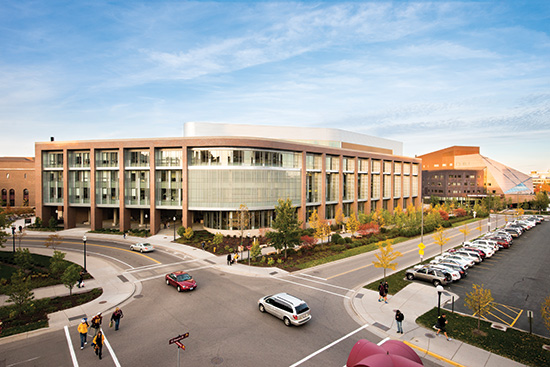
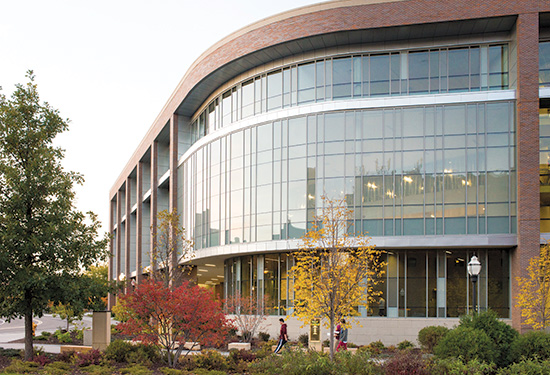
Photos courtesy of Tubelite and Wausau Window and Wall Systems/ Ryan Siemers
While storefront systems may be used in first floor settings, many options are available for high-performance curtain wall systems for both low-rise and high-rise buildings.
Curtain wall systems are generally designed to meet higher performance standards than storefront systems since they are often exposed to harsher conditions. As a complete, multi-story exterior envelope facade system, they provide a non-structural, relatively lightweight, weather-tight covering on buildings. They impact the design appearance of the exterior of course, but it is their superior performance and carefully engineered assembly that often make them an attractive facade solution. In the case of small, low-rise projects, the system may be field fabricated or “stick built” and glazed using standard components similar to a storefront system. For larger, multi-story projects with repetitive and large-scale surfaces, pre-fabricated and factory glazed or “unitized” systems may be warranted to create a monolithic assembly. In either case, curtain wall systems are generally installed outside of the structural system of a building running past floor slabs and other structural elements. They are then attached via tiebacks directly to the building structure at floors, columns, and beams. This installation process means that all excess wind loads and dead loads imposed on the fenestration system are compartmentalized and transferred directly to the building structure. Hence the curtain wall system carries only its own weight and loading while the building structure absorbs all imposed loads.
Since the structural performance of curtain wall systems is based on transferring loads to the building structure, their size is virtually unlimited horizontally or vertically as long as the building is designed to carry the transferred loads. From a thermal performance standpoint, curtain wall systems are typically capable of superior thermal results based on meeting higher wind pressure ratings, tighter seals against weather and more attention to glazing options. The material of choice is aluminum with manufacturers offering anodized finishes ranging from clear to earth tones including tans and blacks. There are also numerous painted colors available with 10-year standard finish guarantees.
Notice

www.acpexpress.com

www.buildabetterbarrier.com

www.fibertite.com
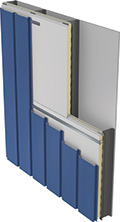
www.metlspan.com

www.parex.com
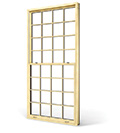
www.pellacommercial.com
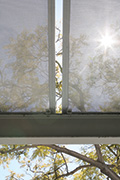
www.sergeferrari.com

www.tubeliteinc.com









